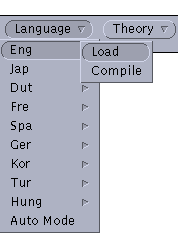

 Miscellaneous
Miscellaneous
User Defaults


 Miscellaneous
Miscellaneous
|
 |
 |
|
| Language-Specific Files |
| The Language Menu |
| Language source files | |
lexiconLang.pl |
Lexical entries and morphology |
parametersLang.pl |
Parameters for X-bar theory and other principles |
peripheryLang.pl |
Language-particular rules |
| GLR machine-generated files | |
transitionLang.pl |
State transition table |
actionLang.pl |
Shift/reduce action table |
igoalsLang.pl |
Goals for principle-interleaving and head movement |
commentsLang.pl |
Comments for GLR debugger |
In general, loading a language means loading the language-particular
elements of the theory: namely, the parameters, lexicon and
periphery files. The parser also uses a set of GLR machine files which
specify a bottom-up stack-machine-based parser (built specifically)
for the language. When the user selects an entry from the
Language menu, PAPPI will load in both sets of files:

(The details of this menu will be covered later in the next section.)
The grammar associated with the GLR machine is determined by the
language-independent X-bar rule system in conjunction with the word-order
specifications mentioned in the parameter file. The lexicon also
plays a part in shaping the GLR machine. The range of possible
subcategorization frames licensed for a given language is determined
by its lexical entries. For more details on the organization of the
grammar rule system, see the Phrase Structure
Rules chapter. The GLR machine files are generated by selecting the
GLR Machine Build command under the
Theory menu, as shown below:

init/Nlanguage_info. The file contains
one line per menu entry or language. The format of each line is as follows:
<language> <flag icon path> <large flag icon path> <16pt 2 byte font> \ <24pt 2 byte font> <encoding>The elements are explained below:
<language> |
The name of the language,
e.g. Eng. |
||||
The characters of the name will be used as a suffix to construct the
relevant file names during language loading,
e.g. lexiconEng.pl and transitionEng.pl.
|
|||||
<flag icon path> |
This is the pathname of the flag that is displayed for the language: | ||||
|

By convention, the flag is stored in the The file is encoded using the popular XPM format:
/* XPM */
static char * usa [] = {
"60 39 4 1",
" m black c #2D2D5B5BE5E5",
". m black c #E5E52D2D2D2D",
"Y m white c #E5E52D2D2D2D",
"X m white c #FFFFFFFFFFFF",
" .Y.Y.Y.Y.Y.Y.Y.Y.Y.Y.Y.Y.Y.Y.Y.Y.Y",
" Y.Y.Y.Y.Y.Y.Y.Y.Y.Y.Y.Y.Y.Y.Y.Y.Y.",
" XX XX XX XX XX XX .Y.Y.Y.Y.Y.Y.Y.Y.Y.Y.Y.Y.Y.Y.Y.Y.Y",
" XXXXXXXXXXXXXXXXXXXXXXXXXXXXXXXXXX",
" XX XX XX XX XX XXXXXXXXXXXXXXXXXXXXXXXXXXXXXXXXXX",
" XXXXXXXXXXXXXXXXXXXXXXXXXXXXXXXXXX",
Note: the dimensions of the flag should be 60 x 39 pixels.
|
|||||
<large flag icon path> |
This is an alternate flag used when PAPPI is
started up with option -scale extra_large.
|
||||
For example, bitmap/flag_xl_usa.xpm:
 Note: the dimension of the flag should be 120 x 78 pixels.
|
|||||
<16pt 2 byte font> |
The name of the two-byte gloss font or
nil. |
||||
| This font is used for languages where the input is
given in romanized form, but lexical tree nodes can still be labelled with
native language (double-byte) characters from the font. For example,
from the Korean implementation:
For example, the font used above is: -daewoo-mincho-medium-r-normal--16-120-100-100-c-160-ksc5601.1987-0The k(_) feature is used in lexical entries to encode the
gloss. For more details, see the description in the Word and Lexicon
chapter.
For languages not using the double-byte gloss feature, the value of
this field should be
|
|||||
<24pt 2 byte
font> |
nil or the 24 point
two-byte font used when the tree font size is at least 14
points. |
||||
|
(See the section on Tree
Display for information on tree font attributes.)
For example, here is the difference between the 16 and 24 point glosses given the following font definitions taken from the Japanese implementation: Jap bitmap/flag_nippon.xpm bitmap/flag_xl_nippon.xpm kanji16 kanji24 euc
For languages not using the double-byte gloss feature, the value of
this field should be
|
|||||
<encoding> |
euc, big5
or nop for double-byte fonts. |
||||
This encodes the mapping between the value of the k(_)
feature and the font table. See the description in the Word and Lexicon
chapter for more information.
For languages not using the double-byte gloss feature, the value of
this field should be |
|||||
User Defaults 

 Miscellaneous
Miscellaneous
|